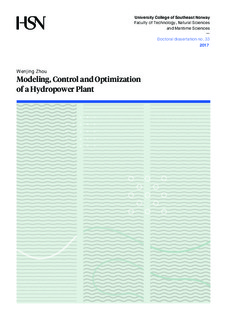| dc.contributor.author | Zhou, Wenjing | |
| dc.date.accessioned | 2018-07-27T12:24:07Z | |
| dc.date.available | 2018-07-27T12:24:07Z | |
| dc.date.issued | 2017-12-19 | |
| dc.identifier.isbn | 978-82-7206-458-6 | |
| dc.identifier.issn | 2464-2843 | |
| dc.identifier.uri | http://hdl.handle.net/11250/2506684 | |
| dc.description.abstract | Hydropower is a crucial power resource for everyday life in Norway, and a traditional industry that could be improved along with new updated technologies. The PhD work focuses on exploring new solutions, in aspect of regulation the water resource, for a hydropower plant.
Prior to develop any control strategy, a mathematical modeling for a hydropower plant is of great importance. Towards acquiring a concise and comprehensive mathematical model, various modeling approaches are introduced to represent the mechanical power input of a single‐unit power plant, which contains of Simple method, Finite volume method (FVM), Method of characteristics (MOC), Electrical circuit equivalent method (EEC). From the simulation results, the Simple method demonstrated its sufficiency for representing the behaviors of the plant and its advantage with consideration of computationally complexity for subsequence controllers’ developments. For manipulation electricity production of a hydropower plant, it is the key point that controlling the input mechanical power from water, which is transferred to electrical power. According to this essential concept, nonlinear model predictive control (NMPC) is developed regarding two kinds of plants, either with only a single generation unit, or with multiple generation units. The achieved NMPC performs its function fairly better comparing with traditional PI controller under different operation situations in a singleunit plant, as well as its advantage of reducing interaction effects when manipulating multiunits simultaneously in one plant, which are presented with simulation results in this thesis.
The other concerning issue of the PhD work is to assist to security surroundings of hydropower plant from flood, and in the meanwhile, optimize the utilization of water. As a result, an optimizer is developed to achieve this purpose, which can produce a control trajectory of a Model Predictive Control (MPC) developed for floodgate with a prediction of a period ahead, and update a decision trajectory of discharging flow that maximize electricity production under the circumstance of safety. The simulation results are presented for a water reservoir of a specific hydropower plant and made a comparison with its historical operation, which has shown that there is some room for enhancing the electricity production if it is under the operations generated from the optimizer rather than with historical operations.
Modeling, control and optimization are the main tasks of this PhD work. The thesis lays out all the details of how the NMPC and optimizer are brought out, the reasons and context for the motivations of why such a work is proposed for hydropower plant. | nb_NO |
| dc.language.iso | eng | nb_NO |
| dc.publisher | University College of Southeast Norway | nb_NO |
| dc.relation.ispartofseries | Doctoral dissertations at the University College of Southeast Norway;33 | |
| dc.relation.haspart | Paper A1: Zhou, W., Sharefi, B.R., Lie, B. & Glemmestad, B.: Modelling and control of a typical high head hydropower plant. © 2011 IEEE. Reprinted, with permission from Proceedings of the 2011 World Congress on Engineering and Technology Oct. 28 - Nov. 2, 2011, Shanghai, China, p. 36-42. ISBN 978-1-61284-363-6. | nb_NO |
| dc.relation.haspart | Paper A2: Zhou, W., Thoresen, H.M. & Glemmestad, B.: Application of Kalman filter based nonlinear MPC for flood gate control of hydropower plant. © 2012 IEEE. Reprinted, with permission from IEEE Power & Energy Society General Meeting. https://doi.org/10.1109/PESGM.2012.6344603 | nb_NO |
| dc.relation.haspart | Paper A3: Zhou, W. & Glemmestad, B.: Implementation of unscented Kalman filter for nonlinear state estimation in hydropower plant. © 2012 IEEE. Reprinted, with permission from 2012 IEEE International Conference on Power System Technology (POWERCON). https://doi.org/10.1109/PowerCon.2012.6401460 | nb_NO |
| dc.relation.haspart | Appendix B: Sharefi, B.R., Zhou, W., Glemmestad, B. & Lie, B.: The effects of compressibility of water and elasticity of penstock walls on the behavior of a high head hydropower station. SIMS 2011 the 52nd International Conference of Scandinavian Simulation Society, Västerås, Sweden. Abstract only | nb_NO |
| dc.relation.haspart | Appendix C: ODE solver | nb_NO |
| dc.rights | Navngivelse-Ikkekommersiell-DelPåSammeVilkår 4.0 Internasjonal | * |
| dc.rights.uri | http://creativecommons.org/licenses/by-nc-sa/4.0/deed.no | * |
| dc.subject | modeling | nb_NO |
| dc.subject | hydropower plants | nb_NO |
| dc.title | Modeling, Control and Optimization of a Hydropower Plant | nb_NO |
| dc.type | Doctoral thesis | nb_NO |
| dc.description.version | publishedVersion | nb_NO |
| dc.rights.holder | © 2017 Wenjing Zhou, except otherwise stated | nb_NO |
| dc.subject.nsi | VDP::Technology: 500::Electrotechnical disciplines: 540::Electrical power engineering: 542 | nb_NO |

